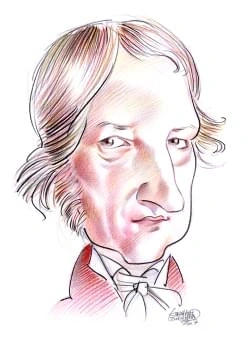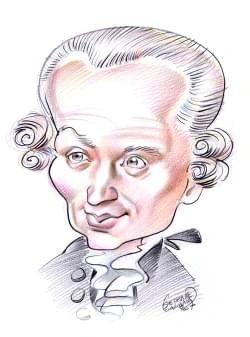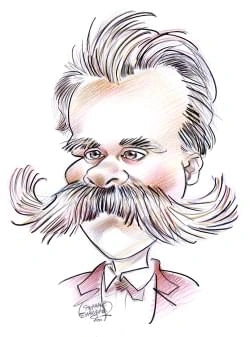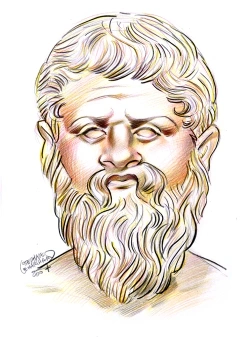400 résultats pour "greeks"
-
Hera (Lady) Greek Queen of Olympus, sister
and wife of Zeus, daughter of Cronus and Rhea.
union was born Centaurus, father of the Centaurs. Ixion was bound to a fiery wheel and doomed to whirl perpetually through the sky. Hera and Io One of the loves of Zeus was the maiden Io. Zeus turned Io into a beautiful white cow to protect her from Hera, but Hera was not deceived. She demanded to be given the heifer and Zeus could not refuse her. Hera then tied up the heifer and the hundred-eyed Argus guarded her. The god Hermes rescued Io by using songs and stories to close all the eyes of A...
- Oceanids (Oceanides) Greek The many daughters of the two Titan deities, Oceanus, the ancient god of water, and his wife and sister, Tethys.
- Sagittarius (The Archer) Greek A constellation in the night sky of the Northern Hemisphere between Scorpio and Capricorn; the ninth sign in the Zodiac.
- Nestor Greek King of Pylos (on the west coast of Messenia, in the Peloponnesus) and, at 60 years old, the oldest and most experienced of the chieftains who fought in the Trojan War.
- Oceanus Greek The Titan son of Gaia and Uranus and the brother and husband of the Titan Tethys; father of all the Oceanids and all the rivers and seas of the world.
- Nike (Nice; Victory) Greek The spirit of victory; a demigod or lesser goddess; daughter of the Titan Pallas and the water Nymph Styx; sister of Bia (Force), Cratus (Strength), and Zelus (Zeal).
- Midas Greek A mythical king of Phrygia, an ancient region of central Asia Minor; son of the goddess Cybele and Gordius, from whom he inherited the throne.
- Hesperides (Daughters of the West) Greek The Dryads, or wood nymphs; sisters, who lived in the beautiful garden on the western edge of the world and helped guard the tree that grew the golden apples of the goddess Hera.
-
- Enyo (1) Greek A goddess of war, specifically known for sacking cities and towns of the enemy; daughter of Zeus and Hera; depicted as the sister, daughter, or mother of the war god Ares, often included as a companion of Ares when he went into battle.
-
Ancient Greece - history.
Palace of KnossosThe ancient city of Knossos was a center of the Minoan civilization, an advanced society on Crete named after Minos, a legendaryCretan king. Skilled in such fields as engineering and architecture, the Minoans constructed the palace at Knossos in 1700 bc. Aserious fire at least three centuries later caused the collapse of the palace and foreshadowed the subsequent decline of the city.Wolfgang Kaehler Settlers had begun sailing from Asia Minor to Crete about 6000 BC because the i...
-
Trojan War - Mythology.
Agamemnon stole Briseis away from Achilles. Furious, Achilles withdrew from the war, causing a serious setback to the Greeks. The quarrel between Achilles and Agamemnon was one of the starting points of the events of the latter part of the Trojan War described by Homer in the Iliad. Later, Achilles would rejoin the war and help bring the Greeks to victory, this time under the leadership of his dear friend Patroclus. Hector killed Patroclus. Achilles then slew Hector and dragged his dead body...
-
Iliad
I
INTRODUCTION
The Abduction of Helen
The Trojan War began with the abduction of Helen, the beautiful wife of the king of Sparta, by the Trojan prince Paris.
Ajax Defends Greek ShipsThe Greek hero Ajax wields his spear in defense of Greek ships as Trojan warriors try to set the wooden vessels on firewith their torches. This encounter, shown in a late-18th-century illustration, occurs in Book 15 of the Iliad, an epicattributed to Greek poet Homer that recounts events from the Trojan War.Corbis Paris offers to fight a duel with Menelaus to settle the conflict. After an exchange of blows, Paris’s protector, the goddess Aphrodite, intervenes to save him....
-
Ancient Greece.
The first culture of Aegean civilization on the Greek mainland is named Mycenaean for the palace at Mycenae on the Pelopónnisos. Scholars call the Mycenaeans the“earliest Greeks” because they are the first people known to have spoken Greek. Mycenaean culture developed later than Minoan. The ancestors of the Mycenaean people wandered onto the mainland from the north and the east from about 4000 to2000 BC, mixing with the people already there, and by about 1400 BC the Mycenaeans had become very...
-
Ancient Greece .
The first culture of Aegean civilization on the Greek mainland is named Mycenaean for the palace at Mycenae on the Pelopónnisos. Scholars call the Mycenaeans the“earliest Greeks” because they are the first people known to have spoken Greek. Mycenaean culture developed later than Minoan. The ancestors of the Mycenaean people wandered onto the mainland from the north and the east from about 4000 to2000 BC, mixing with the people already there, and by about 1400 BC the Mycenaeans had become very...
-
Ancient Greece - USA History.
The first culture of Aegean civilization on the Greek mainland is named Mycenaean for the palace at Mycenae on the Pelopónnisos. Scholars call the Mycenaeans the“earliest Greeks” because they are the first people known to have spoken Greek. Mycenaean culture developed later than Minoan. The ancestors of the Mycenaean people wandered onto the mainland from the north and the east from about 4000 to2000 BC, mixing with the people already there, and by about 1400 BC the Mycenaeans had become very...
-
Cyprus - country.
40,000 cubic meters (1.4 million cubic feet) of salt water into fresh water per day, opened at Dhekelia in 1997, and a second larger plant opened at Larnaca in 2001. III PEOPLE OF CYPRUS The combined population of the Greek and Turkish sectors (2008 estimate) is 792,604. The overall population density is 86 persons per sq km (222 per sq mi). About69 percent of the island’s inhabitants live in urban areas. Greek-speaking Cypriots make up approximately 85 percent of the population. About 12 perc...
-
-
Greece - country.
minerals, such as chromium, copper, uranium, and magnesium, are relatively small. Greece’s small petroleum deposits, located under the Aegean Sea near the island ofThásos, are rapidly being depleted. There are no significant reserves of natural gas. Greece’s forests, probably abundant in ancient times, have been significantly depleted. Subsequent soil erosion has made reforestation efforts difficult. Although muchof Greece’s soil is rocky and dry, the country’s mountains are interspersed with sm...
-
Mythology.
Across cultures, mythologies tend to describe similar characters. A common character is the trickster. The trickster is recklessly bold and even immoral, but through hisinventiveness he often helps human beings. In Greek mythology, Hermes (best known as the messenger of the gods) was a famous trickster. In one version of acharacteristic tale, Hermes, while still an infant, stole the cattle of his half-brother Apollo. To avoid leaving a trail that could be followed, Hermes made shoes from thebark...
-
Acropolis - history.
Peloponnesian War, between Athens and an alliance led by Sparta, finally broke out in 431 BC. Sparta’s alliance defeated Athens, and the Propylaea was never completed. Greek Architectural OrdersThe ancient Greeks developed three major architectural styles, or orders, that determined the major features of a temple facade. TheDoric is the oldest and simplest order. The Ionic and Corinthian orders added a base to the column and developed a more elaboratescheme for the column’s capital. The entabl...
-
Athens (Greece) - geography.
At the heart of the modern city is Syntagma (Constitution) Square, located east of the Acropolis. The square is bordered by the national Parliament Building, originally aroyal palace completed in 1842 for King Otto I. Nearby is the Tomb of the Unknown Soldier, which features a daily changing of the guard. Several of the city’s principalhotels as well the offices of major banks and airline companies also face the square. Behind the Parliament Building is the National Gardens, a public park that i...
-
Achilles
I
INTRODUCTION
Thetis Dipping Achilles in the Styx
The sea nymph Thetis is seen dipping her son Achilles in the River Styx to make him immortal.
Priam Reclaims the Body of HectorThe relief sculpture on this ancient Roman sarcophagus, discovered in northwestern Greece, depicts an event fromHomer’s epic poem the Iliad. In this scene Priam, the king of Troy, reclaims the body of his son, Hector, from the Greekwarrior Achilles, who has killed Hector in battle. Hector’s recumbent body is seen in front of a chariot.Chris Hellier/Corbis Achilles fought many battles during the Greeks’ ten-year siege of Troy. When the Mycenaean king Agamemnon sei...
-
Temple (building)
I
INTRODUCTION
Wat Phra Kaeo
Thailand has nearly 18,000 Buddhist temples, called wats, throughout the country.
colonnaded terraces connected by ramps. The surrounding area was planted with trees and flowers during Hatshepsut’sreign and for many years after.Gian Berto Vanni/Art Resource, NY In ancient Egypt, temples were grandiose, built of huge blocks and columns of stone. Often they were enlarged by successive rulers to form strung-out series of templeparts, as in the gigantic Temple of Amon (circa 1550-1070 BC) at Al Karnak. The Nile cliffs were used as settings for temples, such as the massive mortuar...
-
Geography - Geography.
Geographers have developed a standard pattern of map symbols for identifying such cultural features as homes, factories, and churches; dams, bridges, and tunnels;railways, highways, and travel routes; and mines, farms, and grazing lands. C Analyzing Geographic Information Techniques that use mathematics or statistics to analyze data are known as quantitative methods. The use of quantitative methods enables geographers to treat a largeamount of data and a large number of variables in an objectiv...
-
Aegean Civilization .
warlike. The styles are also more formal and geometric than those of earlier examples, anticipating the art of classical Greece. A typical Mycenaean city had, at its center, the fortress palace of the king. The cities were fortified with massive structures of unevenly cut stones, known as Cyclopeanwalls. The Linear B tablets from this time include names of Greek gods, such as Zeus, and contain detailed records of royal possessions. The gold masks, weapons, andjewelry found by Schliemann at the r...
-
-
Aegean Civilization - USA History.
warlike. The styles are also more formal and geometric than those of earlier examples, anticipating the art of classical Greece. A typical Mycenaean city had, at its center, the fortress palace of the king. The cities were fortified with massive structures of unevenly cut stones, known as Cyclopeanwalls. The Linear B tablets from this time include names of Greek gods, such as Zeus, and contain detailed records of royal possessions. The gold masks, weapons, andjewelry found by Schliemann at the r...
-
Olympic Games.
the next decade nearly all the ISFs abolished the distinction between amateurs and professionals, accepting so-called open Games. One of the most visible examples of the policy change came in 1992, when professional players from the National Basketball Association (NBA) were permitted to play inthe Summer Games in Barcelona, Spain. Professionals from the National Hockey League (NHL) became eligible to participate beginning with the 1998 Winter Olympics inNagano, Japan. V CEREMONIES The Olymp...
-
Theater
I
INTRODUCTION
The Art of Theater
BBC Worldwide Americas, Inc.
Theater at EpidaurusAncient Greek dramas were performed in open-air theaters like this one in Epidaurus, Greece, which was designed byPolyclitus the Younger in 350 bc. A festival of ancient Greek drama is still held in the summer in this 14,000-seat theater.Roger Wood/Corbis Fundamental to the theater experience is the act of seeing and being seen; in fact, the word theater comes from the Greek word theatron , meaning 'seeing place.' Throughout the history of world cultures, actors have used...
-
Athens (Greece) - geography.
expected to further develop the city’s tourism industry. Athens serves as the hub of Greece’s national transportation network. The Greek railway system is centered in Athens, and ferries sail to the rest of the country from theport at Piraeus. The urban area itself in Athens is served by taxis and public buses that must contend with heavily congested traffic. The major part of the city’s metrosubway, Attiko Metro (Athens Metro), was completed in 2000 and serves the heart of Athens; extensions to...
-
History of Astronomy - astronomy.
Egypt, the Sun was directly overhead at noon. On the same date and time in Alexandria, Egypt, the Sun was about 7 degrees south of zenith. With simple geometryand knowledge of the distance between the two cities, he estimated the circumference of the Earth to be 250,000 stadia. (The stadium was a unit of length, derivedfrom the length of the racetrack in an ancient Greek stadium. We have an approximate idea of how big an ancient Greek stadium was, and based on that approximationEratosthenes was...
-
Roman Mythology.
Her temple on the Aventine Hill in Rome was a center for organizations of skilled craftspeople. According to tradition, in 509 BC the dynasty of Etruscan kings ended and the Roman Republic was founded. The republic was ruled by two chief magistrates, called consuls, who were elected by the people to one-year terms. During the time of the republic, the Capitoline temple became the most important public shrine of theRoman people and the focus of public worship. Each January, the new consuls offer...
-
Aristotelianism, medieval
are introduced by the interaction of Aristotle with Jewish, Christian and Islamic religious thinking. The Christianambiguities are perhaps the most familiar. Almost all of the Christian Aristotelians in the Latin West were members ofthe clergy. Most spent their professional lives teaching and writing, not the liberal arts or philosophy, but Christiantheology. It remains controversial whether or to what extent we can find an autonomous or even a textuallydistinguishable Aristotelian p...
-
Ancient Rome .
attributed to Numa, including the selection of virgins to be priestesses of the goddess Vesta. He also established a calendar to differentiate between normal workingdays and those festival days sacred to the gods on which no state business was allowed. His peaceful reign lasted from 715 to 673 BC. Under Tullus Hostilius (672–641 BC) the Romans waged an aggressive foreign policy and began to expand their lands by the conquest of nearby cities like Alba Longa. When the warlike King Hostilius co...
-
-
Ancient Rome - USA History.
attributed to Numa, including the selection of virgins to be priestesses of the goddess Vesta. He also established a calendar to differentiate between normal workingdays and those festival days sacred to the gods on which no state business was allowed. His peaceful reign lasted from 715 to 673 BC. Under Tullus Hostilius (672–641 BC) the Romans waged an aggressive foreign policy and began to expand their lands by the conquest of nearby cities like Alba Longa. When the warlike King Hostilius co...
-
Technology.
loose soil in this region, known as the Fertile Crescent, was easily scratched for planting, and an abundance of trees was available for firewood. By 5000 BC, farming communities were established in areas known today as Syria, Turkey, Lebanon, Israel, Jordan, Greece, and the islands of Crete and Cyprus. Agricultural societies in these places constructed stone buildings, used the sickle to harvest grain, developed a primitive plowstick, and advanced their skills inmetalworking. Trade in flint al...
-
Metropolitan Museum of Art.
B Ancient Near Eastern Art The objects in this department range from a vast geographical area in southwest Asia and northeast Africa from around 5000 BC to around AD 600. Notable works include Assyrian reliefs from the palace of King Ashurnasirpal II at Calah (now Nimrud, Iraq), Sumerian sculpture, Anatolian ivories, Iranian bronzes, and Achaemenidand Sassanian works in silver and gold. C Arms and Armor This department is renowned for its collection of European armor from the Middle Ages (5t...
-
Aristotle.
succession of individuals. These processes are therefore intermediate between the changeless circles of the heavens and the simple linear movements of the terrestrialelements. The species form a scale from simple (worms and flies at the bottom) to complex (human beings at the top), but evolution is not possible. C Aristotelian Psychology For Aristotle, psychology was a study of the soul. Insisting that form (the essence, or unchanging characteristic element in an object) and matter (the commonu...
-
Mythology
I
INTRODUCTION
Mythology, the body of myths of a particular culture, and the study and interpretation of such myths.
usually define a myth as a story that has compelling drama and deals with basic elements and assumptions of a culture. Myths explain, for example, how the worldbegan; how humans and animals came into being; how certain customs, gestures, or forms of human activity originated; and how the divine and human worlds interact.Many myths take place at a time before the world as human beings know it came into being. Because myth-making often involves gods, other supernatural beings, andprocesses beyond...
-
Roman Mythology
I
INTRODUCTION
Roman Mythology, the religious beliefs and practices of the people of ancient Rome.
Aeneas and AnchisesAccording to mythology, Aeneas was a Trojan prince. After Troy fell to the Greeks during the Trojan War, Aeneas traveledto Italy and met and married a woman in the kingdom that occupied the region that would one day become Rome.Through this marriage, Aeneas was the direct ancestor of Romulus and Remus, the legendary founders of Rome. In thispainting he is carrying his father, Anchises, on his back while fleeing from Troy. This painting by Lionello Spada is in theLouvre Museum...
-
Warfare.
organizations as the League of Nations in 1920 and the United Nations in 1945, and détente (suggested for scaling down the cold war). See Arms Control. Modern antiwar sentiment and organized peace movements are derived in large part from the beliefs of religious sects such as the Society of Friends and the MennoniteChurch. The first peace societies in history were established in the U.S. in 1815, and since then pacifists have actively opposed wars and conscription, and promoted thecause of con...
-
Western Philosophy.
the popular belief in personal deities, but he failed to explain the way in which the familiar objects of experience could develop out of elements that are totally differentfrom them. Anaxagoras therefore suggested that all things are composed of very small particles, or “seeds,” which exist in infinite variety. To explain the way in whichthese particles combine to form the objects that constitute the familiar world, Anaxagoras developed a theory of cosmic evolution. He maintained that the activ...
-
-
Bulgaria - country.
E Climate Most of Bulgaria has a continental climate, with cold winters and hot summers. The climate in general is more severe than in other European areas of the samelatitudes, and the average annual temperature range is greater than that of neighboring countries. Severe droughts, frosts, winds, and hail storms frequently damagecrops. A Mediterranean climate, with dry summers and mild, humid winters, prevails in the valley of the southwestern Rhodope Mountains; the northern limit of theclimati...
-
Roma Roman A legendary figure who came to be
worshiped as a goddess, Roma was the personification
of the city of Rome.
became Rome. The first hill people settled appears to have been the Capitoline Hill. Archaeologists have discovered some of the oldest temples to the supreme Roman god, Jupiter, on this hill. According to legend, it was on this hill that Romulus founded his city. The next hill that settlers developed was the nearby Palatine, 1,250 yards to the southeast of the Capitoline Hill. Legend says that Evander, a leader from the Arcadia region of ancient Greece, settled this hill even before Romulus was...
-
Byzantine Empire .
Emperor Alexius I, founder of the Comnenian dynasty, nevertheless appealed to the pope for aid against the Turks. Western Europe responded with the First Crusade(1096-99). Although Byzantium initially benefited from the Crusades, recovering some land in Asia Minor, in the long run they hastened the empire's decline. Italian merchant citieswon special trading privileges in Byzantine territory and gained control of much of the empire's commerce and wealth. The Byzantines experienced a superficialp...
-
Portraiture
I
INTRODUCTION
Portraiture, visual representation of individual people, distinguished by references to the subject's character, social position, wealth, or profession.
CaracallaCaracalla is a Roman portrait bust in marble of the emperor Marcus Aurelius Antoninus, probably done circa ad 215. Theson of Septimius Severus, Caracalla (as he was known) was a brutal man whose qualities come through in this piece withits dramatic realism. The bust, which is now in the Louvre, Paris, evidently served as the inspiration for Michelangelo’sbust of Brutus more than one thousand years later.Bridgeman Art Library, London/New York The first representations of identifiable ind...
-
Iranian Art and Architecture
I
INTRODUCTION
Iranian Art and Architecture, the visual arts of Iran.
The first great development of ancient Persian architecture took place under the Achaemenid dynasty during the Persian Empire, from about 550 to 330 BC. Remains of Achaemenian architecture are numerous, the earliest being ruins at Pasargadae, the capital city of Cyrus the Great. These ruins include two palaces, a sacred precinct, acitadel, a tower, and the tomb of Cyrus. The palaces were set in walled gardens and contained central columnar halls, the largest of which was 37 m (111 ft) in length...
-
Greece Today, a nation in southeastern Europe,
part of the Balkan Peninsula.
artists carved statues and fashioned jewelry to commemorate the gods. The Classical Age was the height of cultural development. Greece 61 During all of its history, Greece was a collection of city-states, or small communities, rather than a nation. These communities organized around individual political ideals, but the people of this peninsula shared a great deal of culture and trade. They shared a common language and common beliefs in the great pantheon of Zeus and the Olympian Gods. Though c...
- Eileithya (Ilithya) Greek Goddess of childbirth.
-
Puzzle.
Visual puzzles involve searching a picture to find hidden or disguised figures or answering a question about some part of a visual illusion. For instance, the popular 19th- century prints of American lithographic company Currier & Ives featured hidden people, animals, and other objects. A 16th-century painting from Bukhara, Uzbekistan,of a camel includes hidden figures of 17 people, 10 rabbits, a monkey, and a dragon (Metropolitan Museum of Art, New York City). B Mathematical Puzzles and Logic...
-
-
Calligraphy
I
INTRODUCTION
Japanese Calligraphy
This hanging scroll is an example of Japanese calligraphy.
Section of the Egyptian Book of the DeadThe Egyptian Book of the Dead was a text containing prayers, spells, and hymns, the knowledge of which was to be usedby the dead to guide and protect the soul on the hazardous journey through the afterlife. This section of one such book,dating from the early 19th Dynasty, shows the final judgment of the deceased (in this case Hu-Nefer, the royal scribe)before Osiris, the god of the dead. Hieroglyphs as well as illustrations portray the ritual of weighing t...
-
Aegean Civilization - history.
powers of the sea, which was central to Cycladic life. IV HISTORICAL RECORD Recent archaeological discoveries, such as the excavated village of Dimini in Thessaly, produced material evidence of a cultural progression from the Neolithic (New StoneAge) to the Bronze Age, which commenced about 3000 BC and of which three phases were recognized: Early, Middle, and Late. A Early Bronze Age Cycladic FigureStylized marble figures, like this one, are distinctive of Cycladic culture, the earliest cultur...
}})








